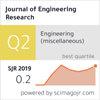Evaluation of significant greenhouse gas emissions reduction using hydrogen fuel in a LFG/Diesel RCCI engine
IF 0.9
4区 工程技术
Q3 ENGINEERING, MULTIDISCIPLINARY
引用次数: 0
Abstract
The production of solid waste in human societies and the related environmental and global warming concerns are increasing. Extensive use of existing conventional diesel and dual-fuel engines also causes the production of high levels of greenhouse gases and aggravating the aforementioned concerns. Therefore, the aim of this study is to reduce the greenhouse emissions in existing natural gas/diesel dual-fuel heavy-duty diesel engine. For this purpose, changing the type of combustion to reactivity-controlled compression-ignition combustion and using landfill gas instead of natural gas in a dual-fuel engine were simultaneously implemented. Moreover, a traditional method was used to evaluate the effect of variations in three important parameters on the engine's performance in order to determine the appropriate engine operating ranges. The simulation results indicate that although the consumption of 102,000 cubic meters per year of natural gas in each cylinder is reduced only by replacing landfill gas, the level of engine greenhouse gas emissions is too high compared to the relevant levels of emissions standards. Hence, by keeping the total energy content of the fuels constant, landfill gas enrichment with hydrogen was considered to reduce the engine emissions. The simulation results show that by increasing the hydrogen energy share up to 37%, the engine load has the potential to be improved up to 7% without any exposure to diesel knock. However, the downfall is the reduction in the gross indicated efficiency up to 3%. Meanwhile, not only the fifth level of the European emission standard for nitrogen oxides and the sixth level of this standard for carbon monoxide can be achieved, but it is also possible to overcome the high level of unburned methane as a drastic greenhouse gas and formaldehyde as a related carcinogenic species.
评估在液化气/柴油 RCCI 发动机中使用氢燃料显著减少温室气体排放的情况
人类社会中固体废物的产生以及相关的环境和全球变暖问题正在增加。广泛使用现有的传统柴油和双燃料发动机也会产生大量的温室气体,使上述问题更加严重。因此,本研究的目的是减少现有天然气/柴油双燃料重型柴油机的温室气体排放。为此,将燃烧方式改为反应控制压燃燃烧,并在双燃料发动机中同时使用垃圾填埋气代替天然气。此外,采用传统方法评估了三个重要参数的变化对发动机性能的影响,以确定发动机的合适工作范围。仿真结果表明,虽然仅通过替换填埋气就可以减少每缸每年102,000立方米的天然气消耗,但与相关排放标准水平相比,发动机温室气体排放水平过高。因此,通过保持燃料的总能量含量不变,用氢富集垃圾填埋气体被认为可以减少发动机的排放。仿真结果表明,通过将氢能份额提高到37%,在不受柴油爆震影响的情况下,发动机负载有可能提高到7%。然而,其缺点是总指示效率降低了3%。同时,不仅可以达到欧洲氮氧化物排放标准的第5级和一氧化碳排放标准的第6级,而且还可以克服高浓度的未燃烧甲烷(强烈的温室气体)和甲醛(相关的致癌物质)。
本文章由计算机程序翻译,如有差异,请以英文原文为准。
求助全文
约1分钟内获得全文
求助全文
来源期刊

Journal of Engineering Research
ENGINEERING, MULTIDISCIPLINARY-
CiteScore
1.60
自引率
10.00%
发文量
181
审稿时长
20 weeks
期刊介绍:
Journal of Engineering Research (JER) is a international, peer reviewed journal which publishes full length original research papers, reviews, case studies related to all areas of Engineering such as: Civil, Mechanical, Industrial, Electrical, Computer, Chemical, Petroleum, Aerospace, Architectural, Biomedical, Coastal, Environmental, Marine & Ocean, Metallurgical & Materials, software, Surveying, Systems and Manufacturing Engineering. In particular, JER focuses on innovative approaches and methods that contribute to solving the environmental and manufacturing problems, which exist primarily in the Arabian Gulf region and the Middle East countries. Kuwait University used to publish the Journal "Kuwait Journal of Science and Engineering" (ISSN: 1024-8684), which included Science and Engineering articles since 1974. In 2011 the decision was taken to split KJSE into two independent Journals - "Journal of Engineering Research "(JER) and "Kuwait Journal of Science" (KJS).
 求助内容:
求助内容: 应助结果提醒方式:
应助结果提醒方式:


